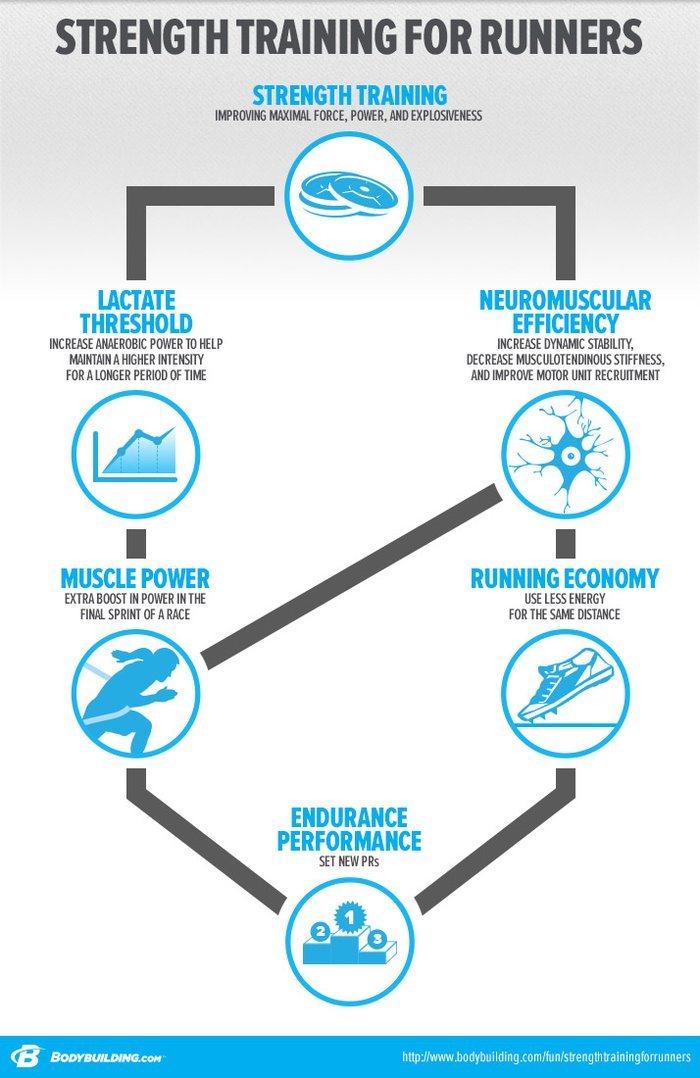Strength training bolsters runners’ performance and reduces injury risks. It enhances endurance, power, and running economy.
Engaging in strength training is pivotal for runners aiming to elevate their racing efficiency and prevent common musculoskeletal injuries. By incorporating exercises focused on core, leg, and upper body strength, runners ensure a balanced approach to their conditioning routine. Strength workouts, when integrated into a training plan, contribute to improved muscle coordination and greater force output during each stride, which can translate into faster and more resilient running.
This not only has the capacity to shave off seconds or even minutes from a runner’s personal record but also fortifies the body against the relentless impact of pounding pavement or trails. Tailoring a strength program to align with individual running goals and the demands of specific races is essential for optimizing athletic performance and achieving long-term success in the sport.

Credit: www.outsideonline.com
The Runner’s Edge: Strength Training Benefits
Runners gain an edge with strength training. It’s not just about speed. It builds power, endurance, and balance. It helps you run faster, longer, and injury-free. Let’s explore the benefits deeply.
The Speed-endurance Connection
Strength training boosts a runner’s performance. Here’s how:
- Improves efficiency: It makes your muscles more powerful.
- Increases stride length: You can cover more ground with each step.
- Enhances endurance: Your muscles won’t tire as quickly.
These benefits mean one thing – faster run times with less effort.
Injury Prevention Through Muscular Balance
Running often uses the same muscles. This can lead to imbalance and injury. Strength training creates balance, making you stronger and less prone to injury. It reduces the risk by:
| Imbalance Issue | Strength Solution |
|---|---|
| Weak Glutes | Squats and Lunges |
| Tight Hamstrings | Deadlifts and Stretching |
| Overused Quads | Reverse Lunges and Step-ups |
Balance means better movement and less pain. It’s essential for continuous running without breaks.
Starting Blocks: Incorporating Strength Work
Starting Blocks: Incorporating Strength Work into a runner’s regimen lays a solid foundation for enduring strides and robust sprints. For many runners, the pathway to improved performance and reduced injury risk weaves through the weight room. Strength training acts not merely as a cross-training activity to running, but as a driver for more powerful and efficient movement.
Balancing Running And Strength Workouts
Harmonizing the rhythm of running and strength sessions is vital. Here’s a simple way to blend them into your week:
- Plan strength days: Twice a week, on non-consecutive days.
- Mix intensities: Follow a hard run with a lighter strength day.
- Recover right: Allow a day of rest or easy running post strength work.
This balance ensures muscles recover, leading to stronger, fresher legs on the run.
Basic Strength Exercises Every Runner Should Know
Key exercises to build a runner’s strength include:
- Squats: They bolster quads, hamstrings, and glutes.
- Deadlifts: These target your posterior chain, crucial for propulsion.
- Planks: Core strength translates into better running form.
- Lunges: Strengthen legs individually for balance and stability.
- Push-ups: Engage the upper body for overall posture and power.
Begin with bodyweight, then add weights as you progress. Consistent practice is key. Commit to these basics, and your running will reap the rewards.
Advanced Techniques For The Long Run
Are you ready to take your running to the next level? Advanced techniques for the long run can help you boost your performance. These methods focus on building strength, increasing speed, and improving endurance. Let’s dive into some powerful training strategies that will keep you ahead of the pack.
Plyometrics For Power And Pace
Plyometrics, or jump training, enhances explosiveness and speed. These exercises give runners an edge on the track. They are the secret sauce for powerful strides and faster paces.
- Box jumps: Leap onto and off a stable platform to challenge your muscles.
- Skater hops: Mimic a speed skater to build lateral strength and agility.
- Burpees: Combine a squat, jump, and push-up for total-body conditioning.
Include these plyometric exercises twice a week for best results. Aim for three sets of ten to push your limits.
Core Stability For Better Running Mechanics
A strong core keeps you stable and efficient during long runs. Good running mechanics reduce injury risk and preserve energy. Core strength ensures proper form and balance throughout your run.
| Exercise | Benefit |
|---|---|
| Planks | Build endurance in abs, shoulders, and back. |
| Russian twists | Improve oblique strength for better torso rotation. |
| Dead bugs | Coordinate limbs while activating the deep core. |
Consistently train your core three times a week. Start with 30-second holds and 15 reps per side to keep your form precise.

Credit: www.pinterest.com
Fueling For The Extra Mile: Nutrition And Recovery
Strength training enhances a runner’s performance. But the right nutrition and recovery are essential. You push your limits. You gain muscle. But without proper fuel and rest, you risk injury and fatigue. This section covers how to eat and recover for strength and endurance.
Optimal Nutrition To Support Muscle Growth
Nutrition is key for muscle repair and growth. Post-run meals should balance proteins, carbs, and fats. Here’s the breakdown:
- Proteins: They rebuild muscle fibers. Aim for lean sources like chicken, fish, tofu, or beans.
- Carbohydrates: They refill energy stores. Choose complex carbs like oats, quinoa, and sweet potatoes.
- Fats: They’re crucial for hormone production. Include healthy fats from avocados, nuts, and seeds.
A table of example post-run meals:
| Meal Type | Protein Source | Carbohydrate Source | Fat Source |
|---|---|---|---|
| Breakfast | Scrambled Eggs | Oatmeal | Chia Seeds |
| Lunch | Grilled Chicken | Quinoa Salad | Olive Oil Dressing |
| Dinner | Baked Salmon | Sweet Potato | Avocado Slices |
Remember to hydrate. Water is vital for nutrient transport and muscle recovery.
Importance Of Rest And Recovery In Strength Building
Rest days are not for skipping. Your muscles need time to repair. Here’s how to make the most of recovery:
- Sleep: Target 7-9 hours nightly. Growth hormone released during sleep repairs muscles.
- Active recovery: Gentle movement like walking or yoga can increase blood flow and help muscle repair.
- Stretching: Regular stretching maintains flexibility and can decrease injury risk.
Plan rest days into your training schedule. Listen to your body. It tells you when to push and when to pause.
Routine Renovation: Periodization For Runners
Introduction ParagraphEmbracing the concept of periodization can transform a runner’s training regimen from monotonous to dynamic. Periodization involves dividing the training calendar into specific blocks, focusing on varied goals. It ensures that strength training aligns with running seasons. Runners can thus achieve peak performance when it counts the most. Let’s delve into how we can renovate our routines with strategic periodization.
H3 Tailoring strength phases to running seasonsTailoring Strength Phases To Running Seasons
Aligning strength training with your running calendar is crucial for optimum performance. Split your training year into phases. Match each phase with your running goals. Here’s how:
- Off-Season: Focus on building muscle and addressing imbalances.
- Pre-Season: Transition to more dynamic, running-specific exercises.
- Competition Season: Prioritize maintenance exercises to support your running.
- Recovery Season: Reduce the intensity and volume to allow for healing.
Tracking Progress And Adjusting For Plateaus
Tracking progress is vital to prevent plateaus. A plateau is when you stop getting stronger or faster. Here’s what you can do:
- Keep a training log: Record your workouts and achievements.
- Set benchmarks: Use these to measure your progress.
- Review regularly: Analyze your log to spot trends.
- Alter your routine: If you hit a plateau, change your exercises.
By implementing these strategies, you’re more likely to see continuous improvement. This approach keeps you moving forward toward your goals.

Credit: www.tonal.com
Success Stories: Testimonials From The Track
Success Stories: Testimonials from the Track showcase the impact of strength training on runners of all levels. From elite competitors to casual hobbyists, hear firsthand how incorporating weightlifting and resistance exercises has transformed their running performance and overall fitness.
Elite Runners Who Swear By Strength Training
Testing your limits on the track requires more than just miles under your feet. Top athletes attribute a portion of their success to strength training routines. They find that a balance between endurance and power is key.
| Runner | Achievements | Training Insights |
|---|---|---|
| Emma Clarke | 5,000m National Champion | Strength training twice a week improved core stability and stride efficiency. |
| Liam Smith | 10k Road Race Winner | Resistant band exercises enhanced recovery and reduced injury. |
Inspirational Transformations Of Hobbyist Runners
Running for fun doesn’t mean shying away from the weight room. Everyday runners too have witnessed the benefits. Strength training can lead to startling improvements and personal bests, making each stride on your jog feel effortless.
- Jane Doe: Started with basic bodyweight exercises; now completes half-marathons with ease.
- John Roe: Added kettlebell workouts, sliced minutes off his 5k time.
These stories inspire runners to consider weights not as optional but as essential. They motivate others to look beyond the track and lace up their gym shoes, aiming for that extra edge. Strength training emerges not just as a companion to running, but as a crucial component for peak performance and injury prevention.
Frequently Asked Questions Of Strength Training For Runners
What Strength Training Should I Do As A Runner?
As a runner, integrate compound movements like squats and deadlifts with core exercises, plyometrics, and upper-body workouts for balanced strength training.
How Many Times A Week Should A Runner Strength Train?
Runners should aim to strength train two to three times per week. It’s essential to balance running routines and full-body workouts for optimal performance and injury prevention.
Should Runners Lift Heavy Or Light?
Runners should incorporate both heavy and light lifting into their training to boost strength and endurance without compromising speed and agility. Tailoring the balance to fitness goals and recovery is essential.
What Exercises Make You A Better Runner?
Strength training, interval sprints, hill workouts, tempo runs, and long-distance runs can improve your running performance. These exercises enhance endurance, speed, and efficiency.
Conclusion
Embracing strength training can significantly enhance a runner’s performance. It’s a game-changer for endurance, speed, and injury prevention. Remember to integrate these exercises into your routine gradually. By doing so, you’ll likely notice improved resilience and faster race times. Every step you take furthers your journey to peak running prowess.


